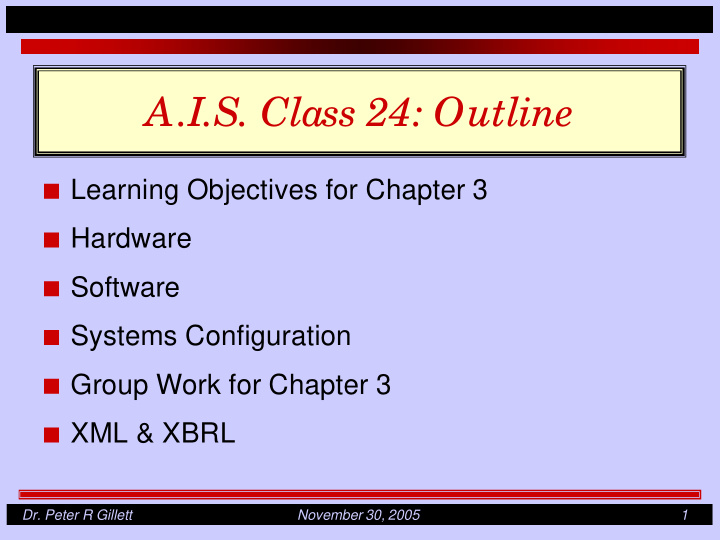



A.I.S. Class 24: Outline I Learning Objectives for Chapter 3 I Hardware I Software I Systems Configuration I Group Work for Chapter 3 I XML & XBRL Dr. Peter R Gillett November 30, 2005 1
Learning Objectives for Chapter 3 I After studying this chapter you should be able to: N describe various information technologies used for data input N explain in some technical detail the components of a computer system N explain the technologies used to process data N describe alternative computer output technologies N distinguish between systems software and applications software Dr. Peter R Gillett November 30, 2005 2
Learning Objectives for Chapter 3 I After studying this chapter you should be able to: N describe the categories and functions of systems software N describe the categories and functions of applications software N briefly describe the issues surrounding systems configurations. Dr. Peter R Gillett November 30, 2005 3
Hardware I Input Technology I Processor Technology I Storage Technology I Output Technology Dr. Peter R Gillett November 30, 2005 4
Input Devices I Keying devices (on-line or off-line) I Mouse (trackball, trackpad, trackpoint) I Light pens I Touch screens I Audio & video input I Bar code scanners, OCR & MICR I POS devices I Scanners Dr. Peter R Gillett November 30, 2005 5
Processor Technology I CPU (registers, control unit, ALU) I Clock I Cache memory I Data bus, address bus, control bus I ISA, PCI, USB, FireWire, Blue Tooth I Processors N 8088, 8086, 80186, 80286, 80386, 80486 DX & SX N Pentium, Pentium Pro, Pentium MMX, Pentium II, Pentium II Xeon, Celeron, Pentium III, Pentium 4 (3.4 GHz) N AMD Athlon XP, AMD Duron, Motorola PowerPC G4 (RISC) Dr. Peter R Gillett November 30, 2005 6
Storage Technology I ROM, RAM, DRAM, SDRAM, ECC, RDRAM, DDR SDRAM, SRAM, Cache I Magnetic tape I Hard disks, floppy disks I EIDE (Ultra ATA), Ultra2 SCSI I Iomega ZIP drives I USB drives (micro, pen, flash drives) I CD-ROM, CD-R, CD-RW I DVD, DVD-R/W, DVD+RW, DVD-RAM Dr. Peter R Gillett November 30, 2005 7
Output Technology I Printers N Dot matrix N Ink jet N Laser I Video display N PCI v AGP N VGA (640 x 480) N SVGA (800 x 600) N XGA (1024 x 768) etc. N TFT I Sound cards, MIDI interfaces Dr. Peter R Gillett November 30, 2005 8
Software I Systems Software I Programming Languages I Application Software � General Purpose � Special Purpose Dr. Peter R Gillett November 30, 2005 9
Systems Software I Operating systems � multitasking, multiprogramming, multiprocessing � DOS, WINDOWS 3.1, 95, 98, ME, NT, 2000, XP, OS/2 Warp 4, Mac OS X, Unix, Linux � GUIs (as opposed to CUI) I Utilities (e.g., virus-scans, disk formatters) I Language translators � assemblers, compilers, interpreters Dr. Peter R Gillett November 30, 2005 10
Programming Languages I First, second, third, fourth generation I Object-oriented programming languages (JAVA, C++) � encapsulation � polymorphism � inheritance Dr. Peter R Gillett November 30, 2005 11
Application Software I General purpose � word processing � spreadsheets � presentation graphics � flowcharting � databases � communication � organizers Dr. Peter R Gillett November 30, 2005 12
Application Software I Special purpose � low-end accounting packages N Quicken, Quickbooks Pro, Microsoft Money, PEACHTREE � mid-range packages N Great Plains Dynamics (now Microsoft), ACCPAC Pro, Platinum � high-end packages N SAP, Oracle, PeopleSoft, JD Edwards (now PeopleSoft), BAAN (now SSA Global) Dr. Peter R Gillett November 30, 2005 13
Systems Configurations I Supercomputers I Mainframes I Minicomputers I Servers I Workstations I Desktops I Laptops (notebooks) I Palmtops (PDAs) Dr. Peter R Gillett November 30, 2005 14
Group Work for Chapter 3 I Discussion Questions I Problems and Exercises 3 Dr. Peter R Gillett November 30, 2005 15
XML & XBRL I SGML � HTML - format � XML - content N XBRL – financial community I XBRL � Fast, accurate searches � Drill-down � Less data re-entry � User choice for disclosure I Microsoft’s .NET initiative Dr. Peter R Gillett November 30, 2005 16
XML Documents I Hierarchical I Self-describing I Directly usable over the Internet I Do not replace HTML I Standards promulgated by W3C I Convert to HTML, spreadsheet, etc. via XSLT I XML Schema – a new standard for defining consistent structure Dr. Peter R Gillett November 30, 2005 17
XBRL I XML-based taxonomy I Common business semantics I Variable output format I Currently: � Financial reporting taxonomies � General ledger taxonomies I Promulgated by XBRL International, created by AICPA, www.XBRL.org I Specification 2.1 issued December 2003 (revised November 2004) Dr. Peter R Gillett November 30, 2005 18
Recommend
More recommend